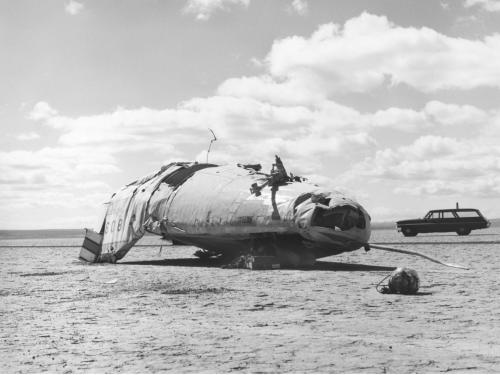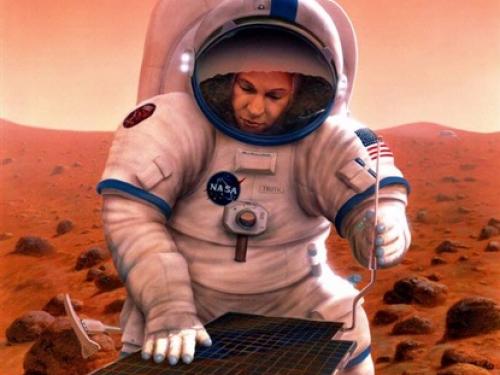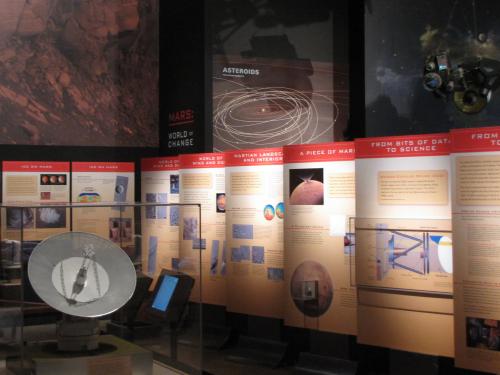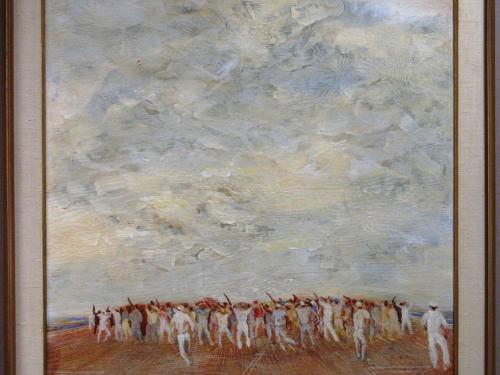
Stories of daring, stories of technological feats, stories of prevailing against the odds ... these are the stories we tell at the National Air and Space Museum. Dive in to the stories below to discover, learn, and be inspired.
Showing 1681 - 1690 of 1761

May 11, 2010
May 10 may ring a bell for fans of the 1970s television show The Six Million Dollar Man. On that day in 1967, a NASA research aircraft, the wingless M2-F2 lifting body, crashed in the California desert. A film clip of the crash opened the popular weekly show about the gravely injured fictional pilot, Steve Austin, played by Lee Majors.

May 09, 2010
In Star Trek: The Next Generation the intrepid crew of the United Starship Enterprise repeatedly face the Borg, cyborgs intent on assimilating the biological creatures of the universe into their collective consciousness. Their meme, “resistance is futile,” serves as a convenient tagline for this ongoing plot device in the fictional series, but it also may foreshadow a more realistic future for humanity as we reach into space. When considering the far future and the potential for humans to colonize other bodies in the solar system and beyond, perhaps humanity will adapt to the space environment through modifications of the human body like those found on the Borg. This idea was first broached by scientists Manfred E. Clynes and Nathan S. Kline in a 1960 NASA study.

May 06, 2010
The superlatives tend to pile up pretty quickly when it comes to the rigid airship Hindenburg, the pride of the Deutsche Zeppelin-Reederei line...It’s a shame, though, that the Hindenburg is remembered today primarily for its tragic final flight.

May 03, 2010
When the National Air and Space Museum opened its doors in July 1976, it featured in its theater a film produced specifically for the Museum called To Fly in a large format called IMAX.

April 26, 2010
Sometimes seemingly ordinary people become extraordinary by staying remarkably calm and capable in a crisis. The crew of US Airways Flight 1549 performed exceptionally on January 15, 2009, when their Airbus A320 jetliner became disabled over New York City after flying through a flock of geese moments after they took off from LaGuardia Airport. Capt. Chesley B. “Sully” Sullenberger and First Officer Jeffrey B. Skiles masterfully guided the powerless aircraft to an emergency “landing” on the Hudson River.

April 22, 2010
On April 28th, we will be awarding the National Air and Space Museum’s Trophy Award for Current and Lifetime Achievement. The Trophy was initiated in 1985 and has been given every year but one since then. This year, the Lifetime Achievement Award will be given to Christopher C. Kraft, Jr., for a lifetime of service to aerospace, especially for his role in defining the responsibilities of Mission Control for human spaceflight at NASA. Anyone who has seen the Hollywood film Apollo 13 knows how crucial the mission controllers were in saving that mission and its crew from disaster. While the filmmakers may have exaggerated a few things, in that regard they were correct. Mission controllers—at first located at Cape Canaveral, later on in Houston—were critical to the success of all the human missions into space, and it was Kraft who determined their roles and responsibilities.

April 19, 2010
I teach an exhibition design course as an adjunct professor for the George Washington University’s Museum Studies program. I tell my students I’ve got the best job in the world: designing exhibitions for the Smithsonian’s National Air and Space Museum. They often ask what you need to know to be an exhibit designer and how they can get there, too.

April 15, 2010
The Exploring the Planets Gallery has been updated to include scientic exlporation of Mars. See what's new!

April 12, 2010
Every year as the anniversary of the first human spaceflight approaches, I receive calls inquiring about the validity of Yuri Gagarin’s claim as the first human in space. The legitimate questions focus on the fact that Gagarin did not land inside his spacecraft.

April 09, 2010
In addition to the “Apollo 11 Codices”, the National Air and Space Museum holds approximately 150 works by the artist Mitchell Jamieson (1915 – 1976). The “Apollo 11 Codices” exemplify Jamieson’s journalistic style of painting, which was one reason NASA brought him into its Fine Art Program. Aboard the U.S.S. Hornet, Jamieson sketched the seamen working to recover the capsule and crew from the successful Apollo 11 mission. Jamieson was known for his depictions of the onlookers at major events rather than the events themselves. This style allows the viewer to believe that they are there as part of the crowd, feeling the energy and excitement. Three of Jamieson’s works are traveling as part of the exhibition “NASA Art: Fifty Years of Exploration” organized by the Smithsonian Institution Traveling Exhibition Service (SITES) in cooperation with NASA and the National Air and Space Museum.
